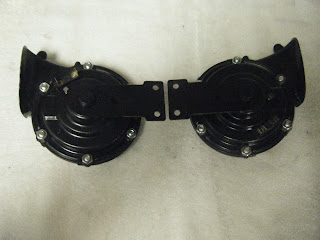Autolite Distributors were installed after 1966 for imported N.American Anglia 105E / 123E, Cortina MK2 '67-70 and Lotus Cortina MK2, including V4 engines.
Autolite produced two types of distributor caps and rotors for the Autolite and later Motorcraft distributors:
 |
| C7BH-12106A (1967) |
 |
| C6AH-12106A (1966) |
Physically the same caps except C7BH has approx. 8 degree advance rotor contact position.
I could not find any information on why Ford decided to develop this new type C7BH cap along with C6AH cap. I can only guess that the Autolite C7BH cap was produced for high revving Lotus Cortina MK2 engine in 1967 which is the correct cap and rotor C6AH-12200A for this model.
C6AH-12200A (1966) DORY-12200A DORY-12200B
The rotor on the left is meant for the 1500 / 1600 GT engine and on the right is a larger area contact rotor meant for the 997 to 1600 standard engines.
According to parts suppliers all caps and rotors are interchangeable but the problem arises when a DORY-12200A ( GT ) rotor combines with a C7BH ( standard ) cap. The rotor doesn't align with contacts of the cap. Moving the distributor to align the contacts will alter the dwell.
In the 105E parts book lists Autolite cap as C6AH-12106A or C7KH-12106A which is the correct cap for a 997/1198 engine but the rotor listed as C6AH-12200A or C7AH-12200A is incorrect. Should have:
DOAH-12200A or DORY-12200B.
Lucas Electrical parts reference for Capri 71-73 1600 and Cortina 67-70 1600 combines RA2 rotor and DC4 cap as a set which is also incorrect. Should be DC7.
Match: Cap C7BH-12106A with Rotor DORY-12200A or DORY-12200B
Match: Cap C6AH-12106A with Rotor DORY-12200B only
No Match: Cap C6AH-12106 with Rotor DORY-12200A
Interchangeable:
Advanced Caps: Ford C7BH-12106A, Motorcraft EDH-13, Lucas DDB757 ( DC7 ),
Niehoff FF 60 E, Standard FD 146, Autolite DHE-155
Standard / Deluxe Caps: Ford C6AH-12106A, C7AH-12106A, DORY-12106A, Motorcraft EDH-12
Lucas DDB754 ( DC4 ), Autolite DHE-156.
Short contact rotors ( GT ): Ford C6AH-12200A, C7AH-12200A, DORY-12200A, Motorcraft DRE-90,
Standard FD-113, Bremi 9563.
Long contact rotors ( Standard / Deluxe ) : Ford DOAH-12200A, DORY-12200B, Motorcraft DRE-91, Standard FD-112.








